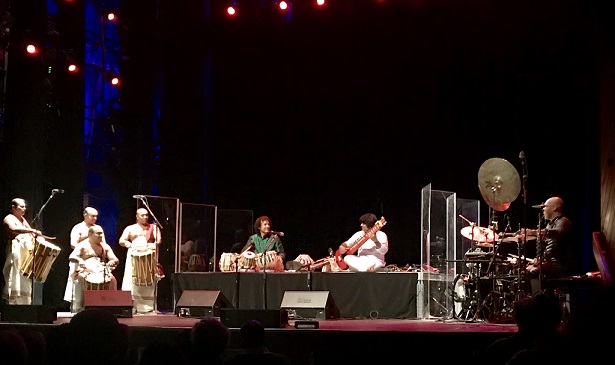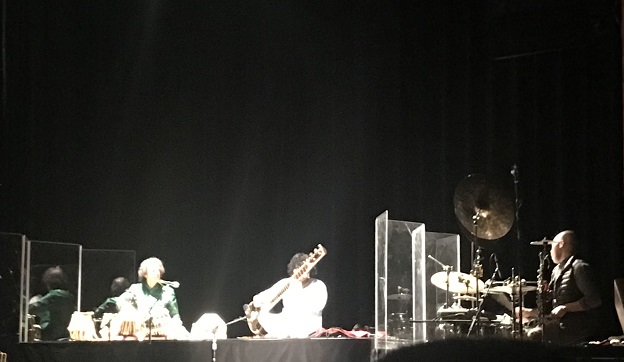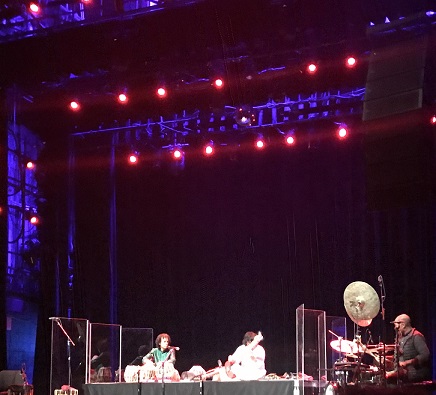Contribute
| Indian Folk, Classical And Western Jazz Traditions Come Together In A Mesmerizing Concert |
Shuchita Rao
04/25/2019
Indian Folk, Classical and Western Jazz traditions Come Together in a Mesmerizing Concert - For the “Masters of Percussion†show presented by WorldCRASHArts on Sunday evening, April 21, there was palpable excitement in the air as the winding, long line of music lovers settled into their seats in the auditorium at Berklee Performance Arts Center, Boston. The audience broke into spontaneous applause as Ustad Zakir Hussain appeared on the stage in a festive, emerald green ethnic Kurta. “Happy Easter†he said, in his signature, cheerful style that immediately put the audience at ease. Pointing to a photograph of his father, the legendary tabla artist, the late Ustad Allarakh, he shared with the audience that his current musical tour would be winding down in eight days and soon, he would be flying to India to celebrate his late father’s hundredth birthday in a grand manner. “A hundred musicians will be coming together from several genres to celebrate the special occasion in a village called Mumbai.†There was laughter at the Ustad’s light-hearted reference to the modern city of Mumbai as a village. Having created a relaxed, congenial atmosphere in the auditorium with his friendly remarks, Ustad Zakir Hussain went on to embark on an exhilarating journey in rhythm with six other seasoned, professional musicians. An ensemble of folk drummers from the Kerala in India, a front-ranking sitar player Shri Niladri Kumar and Eric Harland, described as the most in-demand percussionist of his generation on the Western drums, joined Ustad Zakir Hussain on a memorable journey that lasted 90 minutes. Following a brief and powerful invocatory solo by Padmasri Mattanur Sankarankutty Marar, the lead folk drummer from Kerala, the spotlight turned on Ustad Zakir Hussain who gave a twenty minute long solo presentation on the tabla. Navigating deftly between staggered, variable rhythms, he progressed seamlessly from slow to fast tempo presentation. He played a great variety of sound textures by striking his nimble fingers at different areas of the surface of the tabla such as the black circular centers and the periphery simultaneously on both the baayan(left drum) and the daayan(right drum). The deep tone of the left drum provided a strong contrast to the higher pitched, lightning play of fingers on the right tabla drum. Unlike in the previous year presentations, there was no verbal talk, no accompanying instrument such as the saarangi nor any padhanth (oral recitation of tabla bol or words) in this year’s tabla solo presentation. The hearty and thunderous applause at the conclusion of the tabla solo was testament to the popularity Ustad Zakir Hussain enjoys with Boston audiences. Next, a four member ensemble of Kerala drummers began their group presentation. One of the members played brass cymbals intermittently with his hands. He was flanked on his left and right by drummers with cylindrical, heavy double-headed Chenda drums suspended with red cloth slings around their necks. The drummers used thin sticks instead of their hands to strike their drums. The leader of the group, Shri Sankarankutty sat in front of the three standing percussionists and used a thin stick as well as his bare hand to strike on his large kettle drum. He communicated with his team members (two of them were his sons) with facial expressions such as raising the eyebrow and subtle body movements. After a short “Chenda Melam†ensemble presentation, Shri Sankarankutty led an engaging, rhythmic group conversation with a call-and- response thayambaka exercise with Ustad Zakir Hussain. The ensemble and Zakirji took turns to play creative patterns on their respective instruments. The musicians on the stage were enjoying presenting music as much as the audience was enjoying receiving the music. A couple times, Ustad Zakir Hussain said “Ahas†loudly to convey his joy at the musical conversation between him and the Kerala drummer ensemble. In the next segment of the presentation, the spotlight shifted to the sitar player, Shri Niladri Kumar who commenced with a solo presentation of a deep and sonorous alaap (slow melodic movement) in Raga Kafi. The artist took his time to carefully explore the lower (mandra saptak) musical octave. The use of heavy bass strings amplified with an electric pickup created a haunting atmosphere and the poignant alaap had a calming and meditative effect on the minds of the listeners. A gat composition set to the seven beat rhythm cycle, roopak taal ensued, where Ustad Zakir Hussain accompanied Shri Kumar on the tabla. Shri Niladri Kumar who used a variety of fingering and strumming techniques, displayed terrific command on the rhythm with spontaneous improvisations spanning multiple rhythmic cycles landing squarely on the main beat (the sum) with unflinching accuracy. He took turns with Ustad Zakir Hussain, playing a no-frill refrain repeatedly while the Ustad improvised on the tabla. Together, they played several exciting tihais (a portion of the melodic refrain played thrice) much to the delight of the audience. On the heels of the roopak gat came a faster paced composition in 16 beat cycle teentaal with the refrain beginning on the very first beat (sum) of the rhythmic cycle. At this point, western drummer Eric Harland quietly joined the sitar and tabla duo on the stage, blending his drumming with the flow of Indian classical music in an unobtrusive manner. There were musical conversations between the trio followed by an energy packed rhythm solo by Harland who used both legs and both hands to produce an astonishing array of sounds on his drumset. To contrast the flow of beautiful music, at one point, a brief recorded speech overlay on top of the sitar and tabla sounds added an element of mild, distorted sound. The resulting effect seemed akin to the creation an abstract, modern art painting. In the final segment, towards the end of the concert, Shri Niladri Kumar switched to a smaller sized, bright red Zitar (a combination of sitar and guitar) and played the well known Hindi devotional song “Raghupati Raghva Raja Ram, Patita Paavan Seetha Ramâ€. Lights suspended from the high ceiling above the stage changed into a bright red color, creating a festive atmosphere. All the artists from the Indian folk and classical traditions as well as the Western Jazz tradition collaborated in this instrumental piece to create a spirited and spontaneous offering of music. Caroline from Maynard, MA said “I loved the way all the artists communicated with each other. The music was coming from inside them, as opposed to other Western classical music concerts, where artists may play music by following a pre-composed musical score.†Caroline’s yoga partner, Michael said “I have heard the tabla earlier but this was my first time listening to a sitar. I liked its sound. All the artists were very skilled and the concert was simply, a fantastic treat!†Non-profit music organization, WorldCRASHArts has brought Ustad Zakir Hussain to Boston for several years in succession. Each year, Ustad Zakir Hussain has showcased a different set of masters of great Indian musical folk and classical traditions. While it was the second time for sitarist, Shri Niladri Kumar to visit Boston, it was the first time for drummer Eric Harland and the Kerala folk drummers to join the Masters of Percussion show tour that is traveling across USA giving concerts in several cities. Kudos to the organizers, WorlCRASHarts, for bringing to Boston the much loved Ustad Zakir Hussain “Masters of Percussion†show.
You may also access this article through our web-site http://www.lokvani.com/


